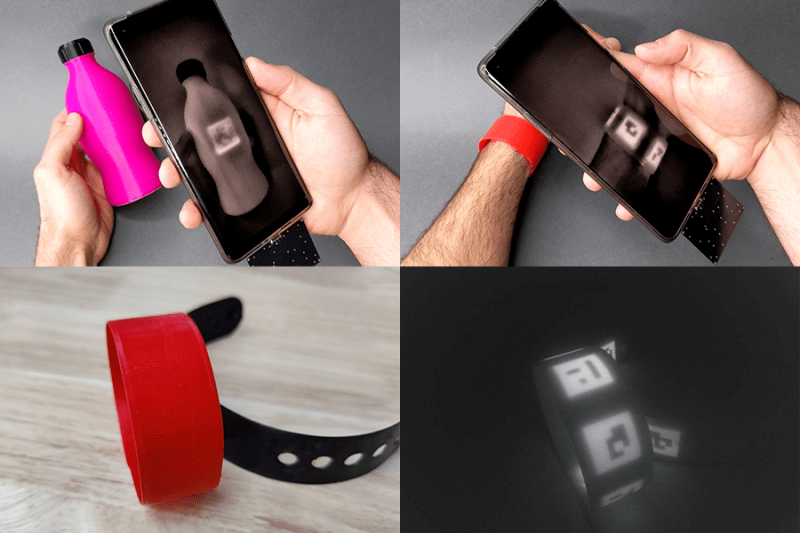QR codes are a handy way to embed information, but they aren’t exactly pretty. New work from MIT’s Computer Science and Artificial Intelligence Laboratory (CSAIL) have a new way to produce high contrast QR codes that are invisible. [PDF]
If this sounds familiar, you may remember CSAILs previous project embedding QR codes into 3D prints via IR-transparent filament. This followup to that research increases the detection of the objects by using an IR-fluorescent filament. Another benefit of this new approach is that while the InfraredTags could be any color you wanted as long as it was black, BrightMarkers can be embedded in objects of any color since the important IR component is embedded in traditional filament instead of the other way around.
One of the more interesting applications is privacy-preserving object detection since the computer vision system only “sees” the fluorescent objects. The example given is marking a box of valuables in a home to be detected by interior cameras without recording the movements of the home’s occupants, but the possibilities certainly don’t end there, especially given the other stated application of tactile interfaces for VR or AR systems.
We’re interested to see if the researchers can figure out how to tune the filament to fluoresce in more colors to increase the information density of the codes. Now, go forth and 3D print a snake with snake in a QR code inside!

















Why would any thieves be lugging any boxes around, when it’d be far easier to just stuff the valuables themselves and anything else they want to grab with them into a gym bag or similar?
Yes, I thought that one was a stretch though, in theory, the boxes with the codes would likely be moved to get at the contents.
If you have a box full of loose jewelry and nothing to carry it in the box could be very handy.
A jewellery box would likely be put straight in a bag or similar. Which would make it vanish from where it was. A lot of the better cctv systems have “object removed” alerting now.
I have been thinking for the past decade that we need a way to embed fluorescent coding in mass-produced materials — not for serial number, but for plastic recycling sorting. In my area black plastic (meaning the vast majority of take-out containers) cannot be recycled because the sorting system doesn’t distinguish the polymer reliably. Putting a mark on these that fluoresces, and making it a code so it can be distinguished from random smears if fluorescing material,seems like it should be a good fix; the challenge would be doing it cheaply enough.
Meanwhile we’re trying to convince restaurants that customers will pay an extra nickel for take-out if it comes in non-black containers, so they can afford to buy more process-friendly ones.
https://www.youtube.com/watch?v=NLkfpjJoNkA
Where i live, 30% of the collected plastics are made into recylate and 15% is recycled by other means. In the beginning it’s all suboptimal and expensive, but systems have improved massively. If we would stop for every project because only 5% succeeded a lot of amazing inventions would never be realized. Having said that, recycling is almost the worst option, better are:
Refuse
Reduce
Rethink
Re-use
Repair
Refurbish
Remanufacture
Repurpose
I’d heard that the reason they can’t recycle black plastic was that it doesn’t show up against the black conveyor belts.
I don’t think it’s desirable to mix fluorescent stuff into black plastic.
What would work though would be using specular reflections / surface texture for identification. No extra material or equipment needed, just new molds.
This was my thought exactly.
The whole thing is a bit silly. Better to put a water soluble IR/UV marker on/in the plastic. Or, just put a barcode or clear recycling instructions on the outside of the plastic! But having something that then goes into the recycling mix means all the next batch of recycling will be glowing, so the next marker will be lower contrast.
There are plenty of “invisible” inks that are visible in ultraviolet, why not just print QR codes with these? And the majority of digital cameras are sensitive to ultraviolet.
UV dyes (“inks”) are not well suited for this task.
“invisible” UV inks absorb in the UV, and fluoresce in the visible, so would be plainly visible to human eyes.
The light produced by these ‘inks’ would be absorbed by common visible-light dyes, so it would be hit&miss whether they are visible. Many visible dyes are transparent in the infrared.
Many plastics absorb in the UV, so the excitation light would not hit the UV dyes if they are printed internally like this.
UV excitation also excites all kinds of other dyes, specifically the brighteners used in white filaments, and pretty much every other white consumer textile or fiber or paper that exists these days.
UV excitation isn’t very nice for human eyeballs. Intense longwave UV can harm the retina. Shortwave UV harms the cornea.
Even if you did use a genuine UV ink that just absorbed and didn’t fluoresce, you are incorrect: ordinary digital camera sensors are essentially blind to UV light.
OK, those are good reasons, thanks.